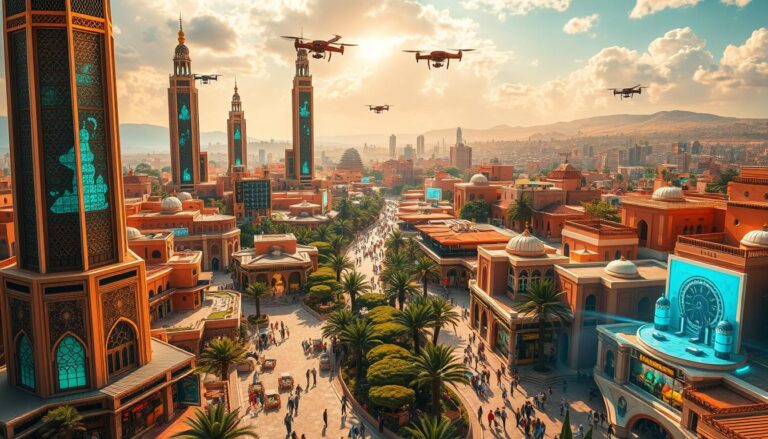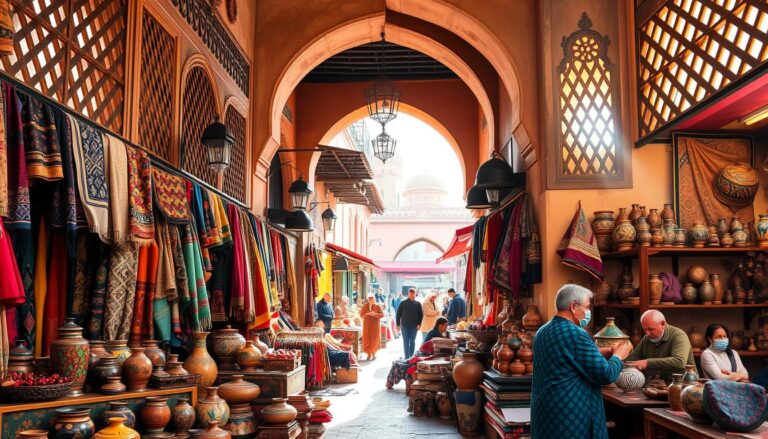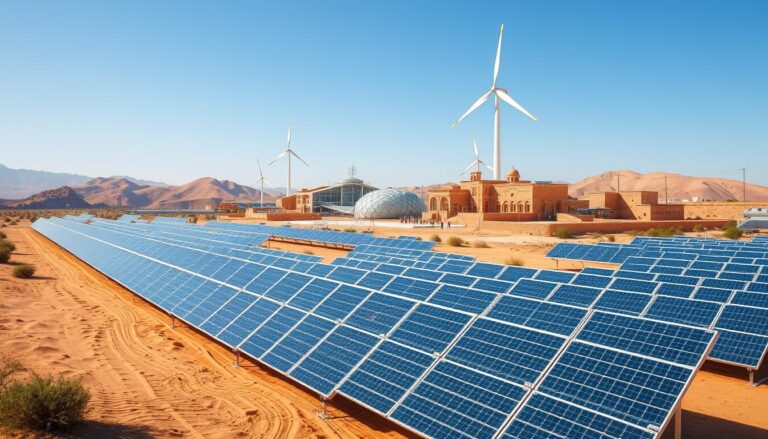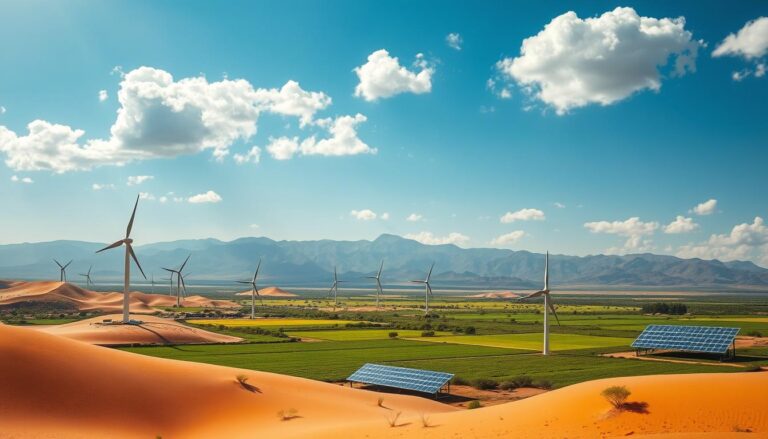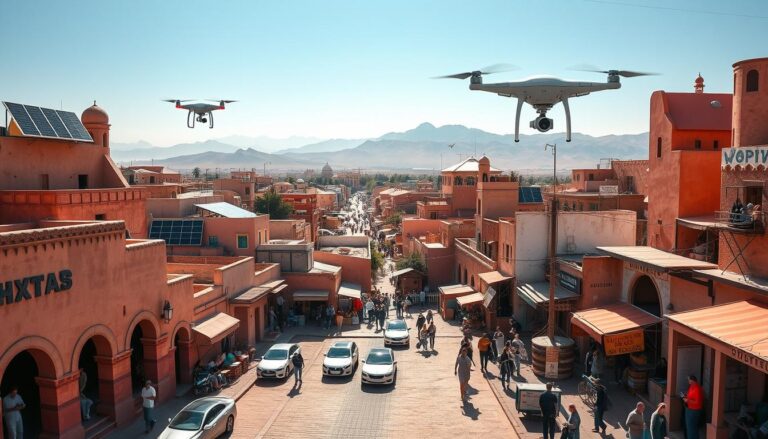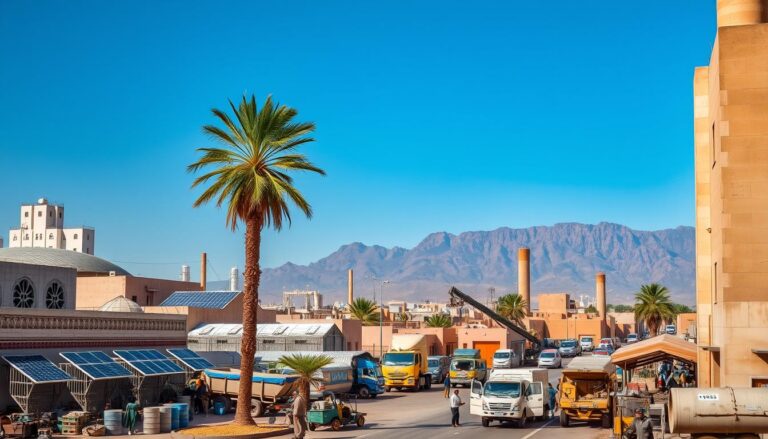What makes a product truly authentic to consumers? It’s not just about quality. It’s also about the culture and heritage behind it. The “Made in Morocco” branding strategy is all about this. It combines Moroccan heritage, craftsmanship, and innovation for a unique global identity.
The Moroccan branding strategy focuses on the real value of “authentic Moroccan products.” It highlights traditional skills and cultural richness. Products like carpets and leatherwork carry more than just a label. They represent quality and heritage.
So, how does the “Made in Morocco” strategy stand out worldwide? It’s all about blending Morocco’s rich history and culture with modern branding. This approach aims to not only improve Moroccan goods but also change how the world sees them.
In this article, we’ll dive into the Morocco branding strategy. We’ll look at its history, culture, and success stories. Join us as we explore the “Made in Morocco” branding strategy and its path to global success.
Introduction to “Made in Morocco” Branding Strategy
The “Made in Morocco” branding strategy aims to make Moroccan products stand out worldwide. It uses key elements like brand essence and visual identity. These help create strong bonds with customers and build loyalty.
At the heart of branding in Morocco is showcasing the country’s rich culture and new ideas through its products. This is seen in Intelcia and the Gen J Innovation Initiative’s work.
Gen J, led by Tarik Haddi, aims to boost entrepreneurship and innovation in Morocco. It works with businesses, schools, and the government. They offer tools, resources, and guidance to new entrepreneurs.
Gen J also conducts a study on innovation in Moroccan businesses. This study looks at R&D investments and how innovation spreads in the economy. It aims to create a Moroccan Innovation Index to track progress.
As promoting Moroccan products grows more important, innovation and branding trends are key. These include tech advancements, sustainability, and changing consumer habits.
Moreover, with free trade agreements, Moroccan consumers face more global products. The agri-food sector is crucial to the economy. So, Moroccan made efforts must compete with international goods to protect and improve domestic product image.
The Importance of Moroccan Heritage in Branding
The Moroccan heritage is key to the nation’s branding. It combines history, culture, and traditional crafts. This mix not only strengthens the Moroccan identity but also boosts its products globally.
Historical Context
Morocco’s rich history shapes its brand. The Alawite kingdom, recognized by WIPO, shows a deep history. This history is at the heart of Morocco’s unique brand image.
Morocco is serious about protecting its heritage. New laws aim to keep its traditions alive. This shows a strong commitment to its past.
Cultural Significance
Morocco’s culture is a big part of its branding. WIPO helps showcase Moroccan products worldwide. This boosts the cultural value of its brands.
The Moroccan Green Plan and Hallieutis Plan show the value of crafts and culture. They create jobs and grow the economy. This highlights the cultural and economic gains from heritage.
Traditional Craftsmanship
Moroccan craftsmanship is authentic and original. It’s a key part of the branding strategy. It shows high-quality work and adds cultural value to products.
Morocco works hard to keep these skills alive. It aims to share its heritage with the world. This will offer unique, culturally rich products globally.
“Morocco is making significant efforts to protect its heritage,” highlights WIPO, showcasing the nation’s strides in cultural preservation and economic advancement.
Holistic Branding Approach for Moroccan Products
Creating a holistic branding approach for Moroccan products means combining different branding elements. It focuses on the brand’s core values and vision. This method ensures that Moroccan branding is consistent and true to its roots. Experts like Dr. Reda Taleb support this approach to build strong brand loyalty.
Integrated brand management brings all aspects of a brand together under one strategy. It pays close attention to customer experiences and visual identity. This way, Moroccan products are not just recognized but also valued. Brands like Intelcia show how aligned messaging can boost market presence and trust.
At the heart of holistic branding are three main parts: defining the concept, analyzing data, and studying successful cases. Marketing experts like Philip Kotler and Harry Beckwith see it as a way to meet human and social needs. They believe it goes beyond just selling products.
Using integrated brand management also means being flexible and creative in a changing world. By understanding what modern consumers want, Moroccan brands can improve their strategy. Advanced models like RoBERTa and BERT help in this effort.
Success Stories of “Made in Morocco” Brands
This section shares the triumphs of Moroccan brands that have adopted the “Made in Morocco” strategy. It highlights examples that show how Moroccan heritage and innovation can build strong brands.
Intelcia’s Holistic Branding
Intelcia, a leading Morocco-born Global Outsourcer Group, has mastered holistic branding. They’ve woven Moroccan cultural values into their brand strategy. This shows how authenticity and local identity can strengthen brand connections.
Intelcia’s branding stands out because it uses storytelling to connect with people. This approach boosts brand awareness. They also use social media to engage audiences in creative ways. Their focus on social responsibility and sustainability makes them a brand with purpose.
Intelcia is a key player in the success stories Morocco story. They show how aligning with local values can lead to a strong market presence. Their journey offers a blueprint for brands wanting to use their heritage and authenticity.
Gen J Innovation Initiative
The Gen J Morocco innovation initiative captures Morocco’s dynamic spirit. It aims to boost innovation and economic growth, making Morocco a center of modern ingenuity. Gen J supports young entrepreneurs and tells brand stories that blend Moroccan tradition with modernity.
Video content is crucial for Gen J, especially short-form videos on TikTok and Instagram Reels. These formats make brand stories interactive and engaging, especially with a younger audience. Authenticity in these stories makes them more persuasive, building a strong connection with consumers.
The success stories Morocco initiative, led by Gen J, shows how investing in innovation can drive growth. Gen J’s approach encourages Moroccan brands to use their rich heritage to create compelling brand stories.
Strategies for Promoting Moroccan Products Globally
To promote Moroccan products worldwide, a mix of strategies is needed. This includes showing off their unique look, improving how customers feel, and using smart ways to talk to people. Each step is important for making Moroccan brands stand out and win over customers.
Leveraging Visual Identity
A strong look for Moroccan products sets them apart globally. Things like traditional patterns, bright colors, and real designs show off their rich history and skill. In places like food, hygiene, and drinks, using pictures is key to reaching people everywhere.
Customer Experience Enhancement
It’s crucial to make customers happy to keep them coming back. This means offering help in French or Arabic, as U.S. companies do. IDFS is working hard to make shopping better by adding more local items at airports.
They also focus on making stores fun and modern. This makes shopping a great experience.
Brand Communication Techniques
Telling the Moroccan brand story well is essential. Using social media and online ads helps reach more people. IDFS is growing its online shop and using digital marketing to connect with customers.
These strategies help Moroccan products shine in the global market. By focusing on looks, customer happiness, and talking to people, Moroccan brands are ready to succeed worldwide.
Role of Territorial Branding in Enhancing Product Value
Territorial branding in Morocco boosts the value of local products. It uses the unique culture and geography of different areas. For example, Tangier is growing fast, thanks to good marketing and planning.
In places like Tangier, branding targets three groups: locals, investors, and tourists. This approach supports economic protectionism. It encourages people to buy Moroccan products.
Marketing strategies for cities greatly affect their reputation. A study on 60 territorial brands found 18 key variables. These help build a strong local brand identity through smart marketing.
In areas like Pla de l’Estany, agrifood branding is key. It focuses on sustainable nature and traditional culture. This approach supports Morocco’s national goals to promote its agrifood products worldwide.
Territorial branding in Morocco uses corporate marketing tactics. It aims to create a strong identity for each region. This helps Moroccan territories stand out on both national and international levels.
Research in Tangier aims to improve city management. It uses tools like documentation review and stakeholder interviews. This ensures branding campaigns are well-planned and effective.
Challenges in Implementing a Comprehensive Branding Strategy
Starting a comprehensive branding strategy is tough for Moroccan businesses. They face many challenges, like competing with global brands and keeping quality high. They also need to find their place in the market.
Competition with International Brands
One big branding challenge Morocco has is fighting against global brands. These brands have a big name and lots of money for marketing. This makes it hard for Moroccan products in international competition to stand out.
Moroccan brands need to be creative and keep trying to find their spot in the market.
Quality Standards and Perceptions
Keeping quality high is key for Moroccan brands wanting to succeed globally. How people see quality affects what they buy. So, it’s important to show that Moroccan products are top-notch.
Brands must focus on quality control and be open about their standards. This is a big part of a strong market positioning strategy.
Market Positioning
Getting a good market position is all about knowing your market well. Moroccan brands need to study their customers and competitors closely. This helps them show what makes them special and different.
This is very important for Morocco’s growing industries. It helps them reach new customers both at home and abroad.
Economic and Social Impacts of “Made in Morocco” Branding
The “Made in Morocco” branding has big effects on the economy and society. It helps create jobs. For example, making Moroccan lounges creates about 40,000 jobs in the craft sector.
This branding also makes Morocco’s market grow. It boosts the nation’s image worldwide. The medical tourism sector, for instance, is growing fast, thanks to Morocco’s health care and tourism goals.
Despite global health issues, Morocco keeps working to stay strong economically. The country’s GDP fell by over 5.8% in 2020. But, programs like Gen J aim to help the economy recover. They focus on creativity and entrepreneurship to boost innovation.
The “Made in Morocco” branding also has social benefits. It makes people proud of their local products. Moroccan lounges, for example, are seen as a status symbol. This encourages families to support local crafts.
Events like the Africa Healthcare and Medical Tourism Summit in Morocco in 2017 also play a role. They show Morocco’s value in medical tourism. They highlight the role of local craftsmanship and innovation in economic and social growth.
In summary, the “Made in Morocco” branding has big effects. It creates jobs, grows markets, and boosts pride in local crafts. These efforts help Morocco’s economy and society grow stronger together.
The Future of Branding in Morocco
The future of Moroccan branding looks bright, thanks to new tech, a focus on the environment, and changing what people want. How these things come together will change the face of branding in Morocco.
Technological Advancements
New tech is changing how brands talk to people. Companies like Gen J and Intelcia are leading the way. They use AI, AR, and more to make branding modern and engaging.
According to the European Commission’s Digital Economy and Society Index (DESI) 2019, Estonia holds the 8th position among the 28 Member States in terms of digitalization progress and is seen as one of the European leaders in digital public services.
Sustainability Practices
Being green is key for brands now, especially in Morocco. Companies like Vita Couture are using solar power and recycling. This shows how brands are choosing to be eco-friendly, which is good for the planet and their image.
Consumer Behavior Trends
What people want is changing fast, with a big push for personal and ethical choices. Moroccan brands are using data to get to know their customers better. This move towards tailored and responsible shopping is important for the future of branding in Morocco.
In short, the mix of new tech, green practices, and changing consumer tastes will shape the future of Moroccan branding. Brands that get this right will lead the way in a fast-changing world.
Conclusion
The “Made in Morocco” branding strategy is a big deal. It mixes cultural heritage with new ideas and quality. This makes Moroccan products stand out and creates a strong brand identity.
Historical context, cultural importance, and traditional skills are key. They help build a brand image that people around the world can connect with.
Companies like Intelcia and Gen J Innovation Initiative show Morocco’s brand success. They use a complete branding approach to grow globally. Moroccan brands can beat international competition by focusing on visual identity and customer experience.
Looking ahead, Morocco’s branding future looks bright. It’s because of changing consumer trends, green practices, and new tech. Moroccan brands will keep their unique charm and make a big impact.
The “Made in Morocco” strategy is a path to success. It also sets the stage for more growth in the global market.
Source Links
- "Made in Morocco: How can nation branding revamp the strategic positioning of Morocco" _Thesis-Defense-Dinia-Jorio
- Dolidol: a showcase for “Made in Morocco” | Proparco
- Innovating for the Future: The Synergy of #HolisticBranding and #GenJ Principles
- Morocco and WIPO seek protection of Morocco’s cultural heritage
- Brand Morocco: embracing modernity wrapped with tradition – VibeMedia
- Elevating Aspect-Based Sentiment Analysis in the Moroccan Cosmetics Industry with Transformer-based Models
- The effect of consumer-based authenticity on attachment and social networks in digital context: Case of Moroccan’s terroir products
- Stories to Tell, Stories to Sell: A Call for Moroccan Brands
- Morocco writes its success story in the automotive industry
- saja design our success is when we feel satisfaction of customers
- Morocco – Selling Factors and Techniques
- Key Factors to Consider When Entering the Moroccan Market
- Morocco’s IDFS outlines its plans and strategies
- Practices of Territorial Marketing in Morocco: A Study of the Experience of Tangier
- Potential and limits for creating a place brand as tool for territorial development in Chefchaouen, Morocco
- BM_Case_FR_F06.ppt
- Beyond the Screen Moroccan Women Crafting Digital Empowerment through Personal Branding in Social Media
- Digital twins: development and implementation challenges within Moroccan context – Discover Applied Sciences
- "Made in Morocco: How can nation branding revamp the strategic positioning of Morocco in the Medical Tourism Industry" _Thesis-Jorio-Dinia
- Two countries that prove nation branding works | Jose Torres, Bloom Consulting
- Fashioning the future
- International brand strategy: Case Analysis According to the Moroccan Market – Research leap
- How Indomie Dominated The Moroccan Market – Abdonejam
- Morocco – United States Department of State

The Editorial Team is a passionate group of Morocco enthusiasts dedicated to sharing the beauty, culture, and wonders of this captivating country. With diverse backgrounds and a deep love for travel, we strive to bring you engaging and informative content that inspires your Moroccan adventures. From uncovering hidden gems and sharing local insights to exploring mouthwatering cuisine and showcasing the vibrant lifestyle, our team is committed to providing you with valuable resources and exciting stories that enhance your exploration of Morocco. Join us on this journey as we celebrate the rich heritage and unforgettable experiences that make Morocco truly special.


